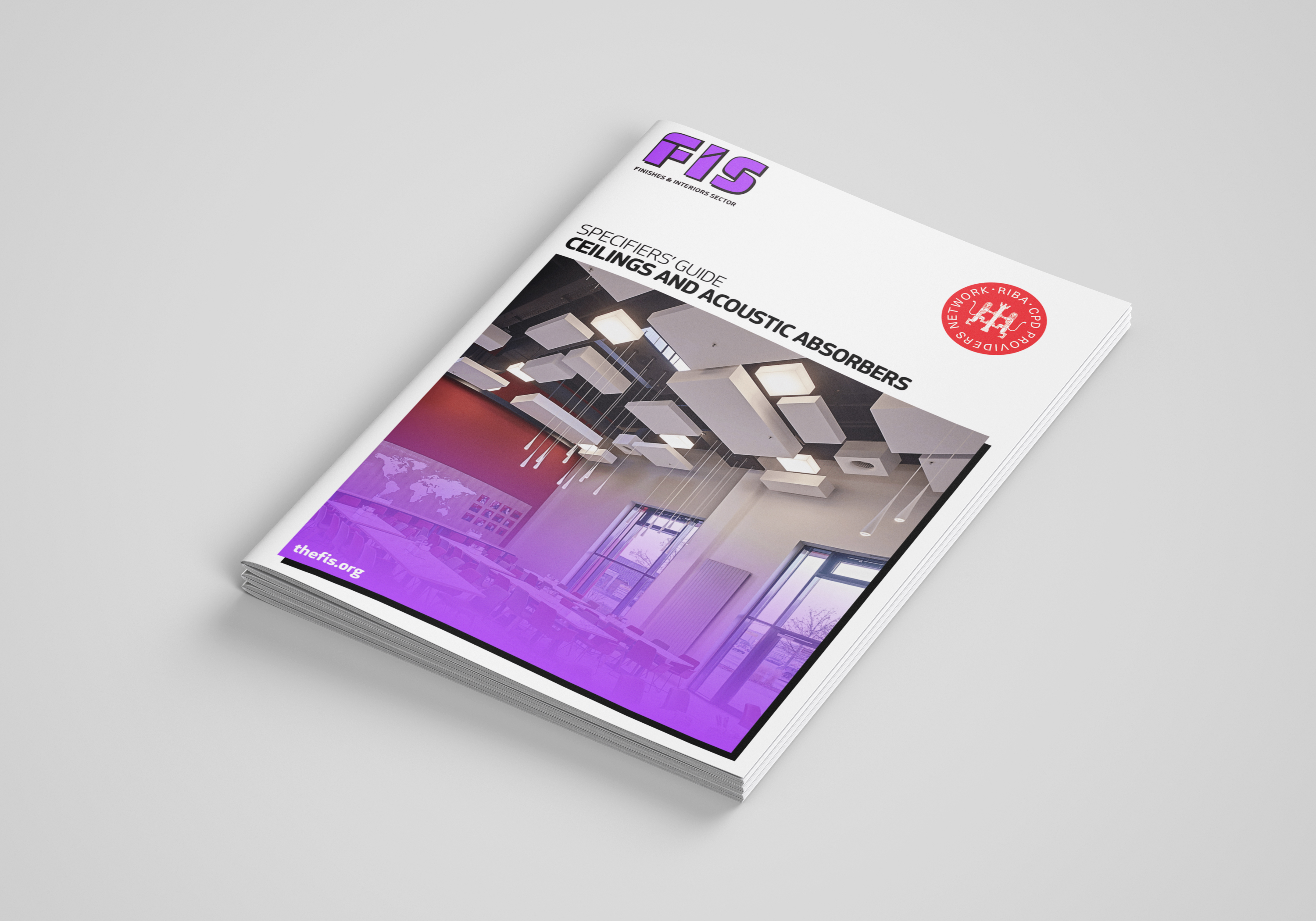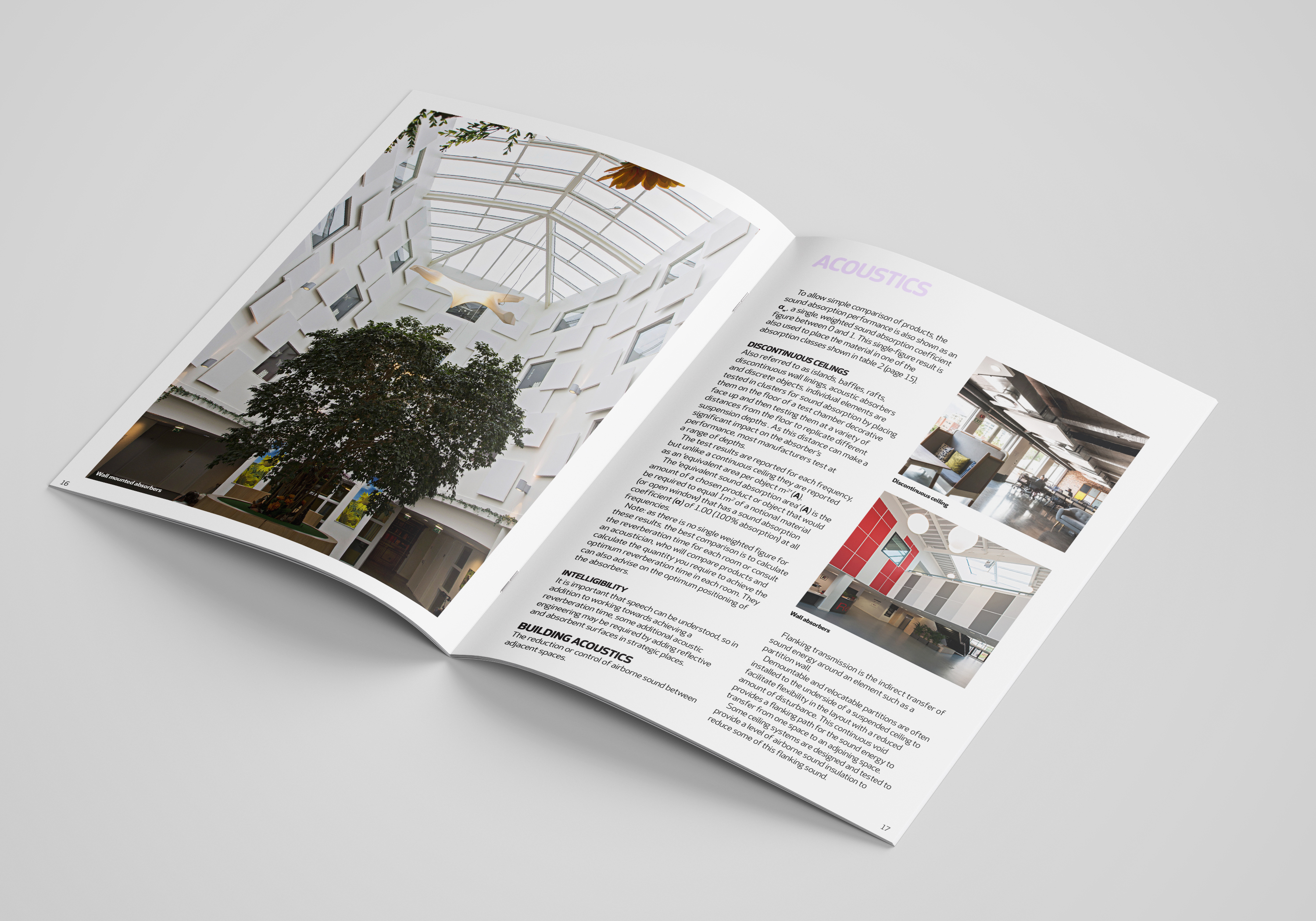Specification Guide to Ceilings and Acoustic Absorbers
Specifiers’ Guide - Ceilings and Acoustic Absorbers was published by the Finishes and Interiors Sector (FIS) in 2021.
It was written and produced by the FIS Ceilings and Absorbers working group which comprises representation from manufacturers, suppliers and contractors involved in the design, supply and construction of ceiling systems
The aim of the guide is to help architects, designers and installers through the criteria in selecting and specifying a suspended ceiling and acoustic absorber that will satisfy the performance needs of an internal space while providing the desired visual effect.
The guide addresses what a good specification looks like and how it should be structured – it even includes 10 top tips to producing a specification. It then breaks down the key performance issues around fire and acoustics and the other issues of volatile organic compounds, light reflectance, impact resistance, air permeability, wind loading, sustainability and conformity marking.
Iain McIlwee, FIS Chief Executive said: “This guide, written by industry specialists, pulls together decades of experience from specification managers who almost instinctively know the questions on all aspects – from performance, material characteristics, sustainability and environmental, conformity marking, installation, maintenance and end of life. In total, there are 36 parameters to consider to ensure a safe, compliant and complete specification. This is crucial if the specification is not to be misinterpreted and any alternatives assessed and checked as equal before approving them.”
The contents of the guide are:
- Foreword
- Introduction
- Scope
- The specification
- Design Considerations
- Performance
- Acoustics
- Other material characteristics
- Sustainability
- Conformity marks
- Material types
- Ceiling Systems
- Installation Considerations
- Top 10 reasons why ceilings fail
- Appendix: regulation and guidance documents, standards
You can download the Specifiers’ Guide - Ceilings and Acoustic Absorbers here.
For further information or for any questions please contact FIS at [email protected] or contact construction marketing communications agency Fabrick.
--FIS
[edit] Related articles on Designing Buildings
- Acoustic consultant.
- Acoustic design for health and wellbeing.
- Airborne sound.
- Approved Document E.
- Ash deafening.
- Audio frequency.
- Building Bulletin 93: acoustic design of schools.
- Building regulations.
- Ceiling tiles.
- Decibel.
- Flanking sound.
- Impact sound.
- Metamaterials.
- Noise nuisance.
- Pre-completion sound testing.
- Reverberation.
- Robust details certification scheme.
- Room acoustics.
- Sound absorption.
- Sound insulation.
- Sound insulation in dwellings: Part 1: An introduction (GG 83-1).
- Sound reduction index (SRI).
- Sound v noise.
- Structure-borne sound.
- Suitable insulation can help preserve the golden sound of silence.
- Suitably Qualified Acoustician.
Featured articles and news
RTPI leader to become new CIOB Chief Executive Officer
Dr Victoria Hills MRTPI, FICE to take over after Caroline Gumble’s departure.
Social and affordable housing, a long term plan for delivery
The “Delivering a Decade of Renewal for Social and Affordable Housing” strategy sets out future path.
A change to adoptive architecture
Effects of global weather warming on architectural detailing, material choice and human interaction.
The proposed publicly owned and backed subsidiary of Homes England, to facilitate new homes.
How big is the problem and what can we do to mitigate the effects?
Overheating guidance and tools for building designers
A number of cool guides to help with the heat.
The UK's Modern Industrial Strategy: A 10 year plan
Previous consultation criticism, current key elements and general support with some persisting reservations.
Building Safety Regulator reforms
New roles, new staff and a new fast track service pave the way for a single construction regulator.
Architectural Technologist CPDs and Communications
CIAT CPD… and how you can do it!
Cooling centres and cool spaces
Managing extreme heat in cities by directing the public to places for heat stress relief and water sources.
Winter gardens: A brief history and warm variations
Extending the season with glass in different forms and terms.
Restoring Great Yarmouth's Winter Gardens
Transforming one of the least sustainable constructions imaginable.
Construction Skills Mission Board launch sector drive
Newly formed government and industry collaboration set strategy for recruiting an additional 100,000 construction workers a year.
New Architects Code comes into effect in September 2025
ARB Architects Code of Conduct and Practice available with ongoing consultation regarding guidance.
Welsh Skills Body (Medr) launches ambitious plan
The new skills body brings together funding and regulation of tertiary education and research for the devolved nation.
Paul Gandy FCIOB announced as next CIOB President
Former Tilbury Douglas CEO takes helm.
UK Infrastructure: A 10 Year Strategy. In brief with reactions
With the National Infrastructure and Service Transformation Authority (NISTA).

























